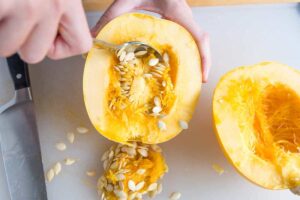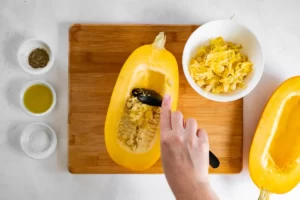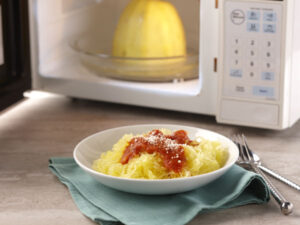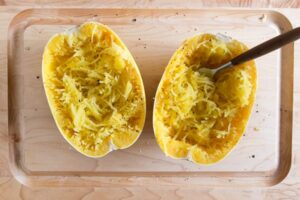Cucurbita pepo subsp. pepo varieties are known as spaghetti squash or vegetable spaghetti. They come in a variety of sizes, colours, and forms, with orange containing the most carotene of all of the accessible varieties.

Many sizable seeds are present in the core. The flesh is firm when uncooked and resembles other raw squash. After being cooked, the fruit’s meat separates from the flesh in ribbons or strands that resemble spaghetti and can be eaten instead of it.
Ultimate Guide For Cooking Spaghetti Squash
All of our best spaghetti squash cooking tips. We demonstrate how to cut, cook, and serve it in the oven, slow cooker, pressure cooker (Instant Pot), or, if time is of the essence, microwave. Spaghetti squash is a versatile vegetable that can be prepared in a variety of ways. Go straight to the Spaghetti Squash Recipe.
The Best Way to Cut Spaghetti Squash
Don’t be alarmed by the spaghetti squash’s tough exterior! We have the secret to safely cutting through it. You can watch me chop the squash in half in the video up above, and I’ve listed the steps we use below.You’ll require: A strong chef’s knife, some force, and a towel to stabilise the squash as you cut (as well as protect your hands) are all required. You can do this.

Use the towel to keep the squash steady. I like to put half of it underneath the squash to keep it from rolling around on me. The other half then sits beneath my hand, allowing me to grip the squash tightly.
Squash should be cut from stem to end. Pierce the spaghetti squash in the middle and cut it from stem to end, but don’t try to cut through the stem (it’s far too tough).
Separate the halves. Wiggle the knife through the squash, then separate the halves. The pulling force will pull one half away from the stem. (Watch the video to see how easy it is.)
Here’s a method to soften the shell of the squash if it’s simply too tough to cut through: With a knife or fork, pierce the squash several times, then score the areas you intend to cut later. Cook it for three to four minutes in the microwave.
The brief microwave exposure helps to soften the outer shell, making it slightly simpler to cut. However, we don’t advise microwaving a full squash for much longer than that because the squash’s interior will begin to build up steam, which might be quite harmful. It should take a few minutes.
Scooping Out The Seeds

Scoop out the seeds after cutting the squash in half. If you like roasted pumpkin seeds, you can make something very similar to spaghetti squash seeds. If you look in the recipe notes section, we’ve shared some tips for roasting them.
Four Ways To Cook Spaghetti Squash
Why do you think we’ve dubbed this the “ultimate guide to cooking spaghetti squash”? Continue reading for advice on how to prepare it in a pressure cooker, a slow cooker, a crockpot, or by baking or roasting it (Instant Pot).
All four techniques are really effective, but I’ll be honest and say that my favourite is roasting spaghetti squash. I adore how the edges start to caramelise slightly.
Baking Spaghetti Squash in the Oven
Follow these simple instructions to bake spaghetti squash in the oven:
Apply olive oil to the squash halves’ interiors (or use melted butter). Salt and pepper are other seasonings I enjoy using. You should also use this opportunity to sprinkle on your preferred spice mixture.
Squash halves should be placed cut-side down on a baking sheet with a rim. The edges of the squash halves caramelise and brown during baking, adding flavour. Additionally, it allows the extra moisture to drip off the squash and onto the baking pan. The liquid would collect in the middle of the squash halves if you baked them cut-side-up.
Bake until the potatoes are fork tender but still a little firm. We try not to overbake the squash, which produces a mushy result, because I like the strands to still have a bit of bite to them.
Here’s another roasting squash tip: Before baking, tuck a few sprigs of fresh herbs under each squash half — rosemary, thyme, sage, and mint are all delicious. This is demonstrated in the video above!
What Is the Best Oven Temperature for Baking Spaghetti Squash?
Although a 375°F oven is preferable, it is acceptable to increase or decrease the temperature by 25°F. There is no need to bother about adjusting the oven temperature if anything else is baking in the oven at the same time. Simply watch the squash while it roasts and remove it when it’s tender but still somewhat hard.
Squash should be baked for 40 to 50 minutes (at 375F). The baking time will change depending on how big or tiny your squash is, so keep that in mind.
Cooking Spaghetti Squash in the Microwave (Quickest Method)
If you need to cook spaghetti squash quickly, the microwave is the way to go. In most recipes, microwaved squash can be substituted for roasted squash.

The amount of time we are willing to wait determines whether we microwave or not. In the end, baked squash is more flavorful. The additional bake time also removes a lot of excess moisture that the microwave does not. However, if you are pressed for time, the microwave is your best friend.
Follow these simple steps to cook spaghetti squash in the microwave:
Scoop out the seeds from the squash and season with olive oil, salt, and pepper.
Put the squash halves cut side down in a baking dish that can be used in the microwave. Water should be poured into the dish until it is about one inch deep.
When the squash is readily punctured with a fork, microwave for another 2 to 5 minutes after checking after 5 minutes. When the squash has cooled, use a fork to scrape out the flesh.
Using a Slow Cooker or Crockpot
Follow these simple steps to cook spaghetti squash in a slow cooker:
Leave the squash whole after rinsing it with water. This method eliminates the need to cut the squash in half.
Prick the squash several times with a fork or small, sharp knife to allow steam to escape while it cooks.
Place the slow cooker lid on and cook on HIGH for 3 to 4 hours, depending on the size of the squash. Check for completion and add more time if necessary. A 3 to 4-pound squash should take 3 to 4 hours. Alternatively, cook on LOW for 5 to 8 hours, depending on size.
Using a Pressure Cooker or Instant Pot
To cook spaghetti squash in a pressure cooker or Instant Pot, follow these easy steps:
Cut the squash in half, then remove the seeds.
Place a trivet or steamer basket inside the pressure cooker (some models come with one).
Place the trivet on top of the chopped squash halves in the cooker, add 1/2 cup of water to the bottom, and then tighten the lid.
7 minutes of high-pressure cooking (for a 3-pound squash). The cooking time won’t begin for 5 to 10 minutes because it will take some time for the pressure cooker to build up.
Press the rapid-release button to relieve the pressure after the cooking period is over. It is okay to open the lid once the floating valve at the top of the pressure cooker drops.
Serving Ideas
As I previously stated, we adore spaghetti squash. It’s a low-carb, low-calorie vegetable that can be used in a variety of delicious dishes.
This chicken with spaghetti squash and parmesan is my favourite spaghetti squash recipe (pictured below). We combine the squash strands with chicken, fresh lemon, and parmesan in this dish. It’s amazing!
Here are lots more suggestions:
Make a spaghetti squash bowl that is influenced by tacos or burritos by using cooked squash as the base and topping it with cheese, guacamole, roasted veggies, and black beans (like the filling for these tacos or these coconut black beans).
Melt the butter, add the parmesan, and toss it with the squash strands. Or use cooked spaghetti squash in place of the noodles in this buttered noodles dish.
Use the sauce from this simple veggie spaghetti for a vegetarian variation or top the squash with this simple homemade beef sauce.
replace the rice in burritos with this. The addition of spicy cauliflower to this veggie tortilla would be fantastic.
Use the spaghetti-like squash strands as noodles in soup. I adore this chicken noodle soup, which would be delicious with squash in place of the noodles.
Ultimate Guide For Cooking Spaghetti Squash
PREP 5minsCOOK 50minsTOTAL 55mins
Four methods for cooking spaghetti squash: oven, microwave, slow cooker, and pressure cooker (like an Instant Pot). We prefer roasting the squash for maximum flavour, but if you are short on time, microwave it. This recipe yields four side portions or two generous servings as a full meal.
WATCH US MAKE THE RECIPE
YOU WILL NEED
1 medium spaghetti squash weighing between 2 1/2 and 3 pounds
1 tablespoon butter or olive oil
Freshly ground black pepper and salt
Sage, mint, rosemary, thyme, and other fresh herbs are wonderful choices.
DIRECTIONS
PREPARE SQUASH
Cut the spaghetti squash in half lengthwise with a heavy chef’s knife — see the notes section or our video for how to do this safely.
Remove the seeds with a spoon and set aside. Drizzle olive oil on the cut side of each squash half, then season with salt and pepper.
Preheat the oven to 375°F. Line a rimmed baking sheet (or large baking dish) with parchment paper.
Bake the squash cut-side down on a baking sheet for 40 to 50 minutes, or until soft and easily pierced with a knife. (If you have any, tuck a few sprigs of fresh herbs beneath the squash cavity — rosemary, thyme, sage, and mint are all delicious.)
After the squash has finished cooking, flip each half over so that the cut side is now facing up and let it cool for about five minutes. To separate the flesh’s “spaghetti-like” strands or noodles, run a fork through it.
MICROWAVED SPAGHETTI SQUASH
Put the squash halves, cut-side down, in a baking dish that can be used in a microwave. Water should be poured into the dish until it is about one inch deep.
When the squash is tender and readily pierced with a knife, microwave it for an additional 2 to 5 minutes after checking it after 5 minutes.
After the squash has finished cooking, flip each half over so that the cut side is now facing up and let it cool for about five minutes. To separate the flesh’s “spaghetti-like” strands or noodles, run a fork through it.
When the squash is done, flip it over so that the cut side is facing up and set aside for 5 minutes to cool. To separate the “spaghetti like” strands/noodles, run a fork through the flesh.
SLOW COOKER SPAGHETTI SQUASH
Instead of cutting the squash in half, leave it whole for this method.
Poke several holes in the squash’s skin with a small, sharp knife. This allows steam to escape. Place the entire squash in a slow cooker. Cook on HIGH for 3 to 4 hours or LOW for 5 to 6 hours with the lid on. Cooking time will vary depending on the size of the squash.

Allow the squash to cool for about 5 minutes before cutting in half. To separate the “spaghettilike” strands/noodles, run a fork through the flesh.
PRESSURE COOKER (INSTANT POT) SPAGHETTI SQUASH
Add 1/2 cup of water to the pressure cooker along with a steamer basket or trivet.
Put the trivet on top of the squash halves. Affix the lid. Choose “Pressure Cook” or “Manual” and cook for 7 minutes at high pressure. It should be noted that the timer won’t start until there is sufficient pressure within the pot, so it can take a few minutes.
ADAM AND JOANNE’S TIPS
To cut spaghetti squash securely, you’ll need a strong chef’s knife, some physical force, and a towel to keep the squash steady as you cut and protect your hands. Slice the squash lengthwise, avoiding the stem (which is too tough to cut through). Pull apart each side of the squash after cutting it in half.
How to Roast the Seeds of a Spaghetti Squash Seeds should be free of pulp and fibrous fibres. For 10 minutes, simmer seeds in salted water. Drain and pat dry. Olive oil and salt should be tossed with the seeds. For 15 to 20 minutes, roast in a 325°F oven. The colour of the seeds won’t change much, but when they’re done, they’ll crunch.
Nutrition Facts: The nutrition facts listed below are approximations. We calculated approximate values using the USDA database. We omitted salt from the calculations because you will need to adjust to your preferences. We assumed four side dishes.
NUTRITION PER SERVING: Serving Size 1/4 of the squash / Calories 70 / Protein 1 g / Carbohydrate 9 g / Dietary Fiber 2 g / Total Sugars 4 g / Total Fat 4 g / Saturated Fat 1 g / Cholesterol 0 mg


Comments are closed.